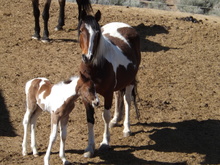Public outrage is rising over a series of inhumane, dangerous and experimental sterilization procedures ;proposed by the U.S. Bureau of Land Management (BLM).

Wild mare with foal at BLM facility
Public outrage is rising over a planned series of inhumane, dangerous and experimental sterilization procedures by the U.S. Bureau of Land Management on 225 mares at the agencyâs Wild Horse Corrals in Hines, Oregon.
© 2016 by AWHPC
The American Wild Horse Preservation Campaign (AWHPC) is decrying the proposed experiments, and today announced that, so far, nearly 13,000 citizens have submitted comments to oppose the experiments in response to an alert that the group released last Thursday.
The BLM intends to conduct sterilization experiments on 225 mares at the agencyâs Wild Horse Corrals in Hines, Oregon in the BLM Burns District.
Of most concern is the plan to use 100 of the mares, 75 of whom will be pregnant in a procedure called âovariectomy via colpotomy,â which involves a veterinarian making an incision in a mareâs vaginal wall, placing his hand and arm through the vagina into the abdominal cavity, manually and blindly locating the ovaries, then severing them with a rod-like chain tool known as an âecraseurâ.
âItâs unconscionable for the BLM to subject wild mares â most of whom will be pregnant â to painful and risky experiments that present grave risks to the mares and their unborn foals, particularly when a proven non-invasive and safe fertility control method exists in the readily available PZP birth control vaccine,â said Suzanne Roy, AWHPC Executive Director.
âInstead of wasting millions of tax dollars to fund experiments on inhumane, impractical and invasive surgical sterilization experiments, the agency should instead focus resources on using the PZP vaccine to safely control population numbers without impacting the natural behaviors of wild horses and without subjecting them to the risk of pain, suffering and death.â
âRemoving the mareâs ovaries will also change the natural, wild behaviors of mares just as it changes the behavior of domestic horses. The behavioral changes will put ovariectomized mares living in the wild at a disadvantage. For all of these reasons the BLM should abort this dangerous and ill-conceived plan.â
Veterinarians consulted by AWHPC confirm that ovariectomy (removal of the ovaries) is an uncommon procedure in domestic horses, but when done, is performed through modern, minimally invasive laparoscopic techniques.
Laparoscopes allow surgeons to visualize abdominal structures with cameras and remove the ovaries through very small incisions in a mareâs sides. By contrast, colpotomy is a blind procedure that requires a vaginal incision large enough for a veterinarian to stick his arm through.
Equine veterinarians have also raised serious concerns about the risks of the procedure â infection, hemorrhage, evisceration (intestines protruding through the incision) and fatality â are increased by the use of wild mares, who cannot be provided with required post-surgical care and will be turned back to their corrals post-surgery with open incisions and no restrictions on movements.
The BLMâs plan to use pregnant mares in the procedures elevates the risk of fatality, abortion and other complications to unacceptable levels.
In domesticated horses, the ovariectomy requires four to seven days of confinement after the surgery, and the first 48 hours are spent in cross ties to prevent the mare from lying down. Such restraint isnât possible in wild horses.
Close monitoring, pain relief and post-surgical antibiotic treatment is also not possible in wild mares.
The public can submit comments on the proposal through Thursday via this link. The full proposal and Environmental Assessment can be found here.
The American WildHorse Preservation Campaign is a national organization dedicated to preserving Americaâs iconic wild horses and burros in viable, free-roaming herds for generations to come, as part of our national heritage. AWHPCâs mission and grassroots advocacy efforts are endorsed by a coalition of more than 60 horse advocacy, public interest, and conservation organizations.
